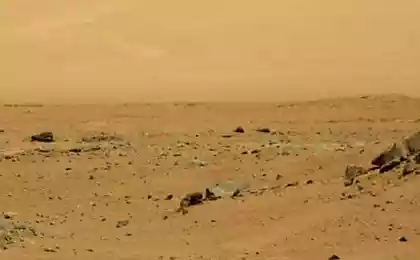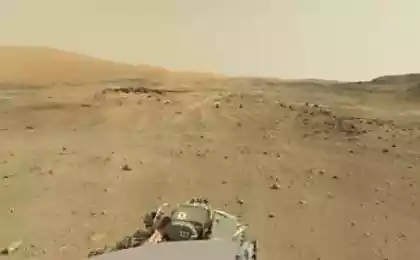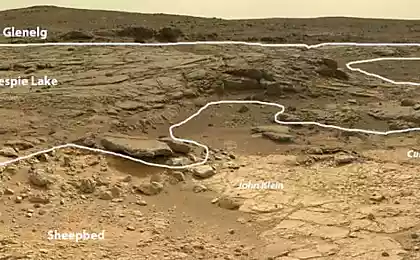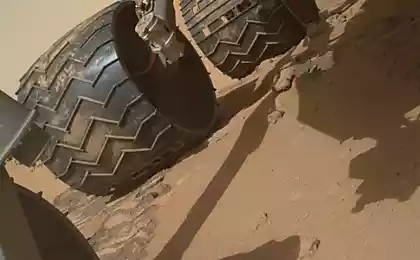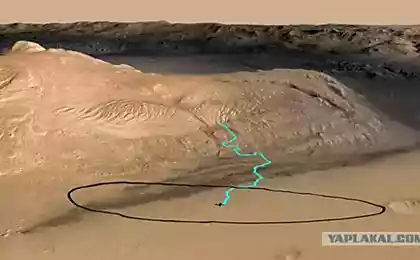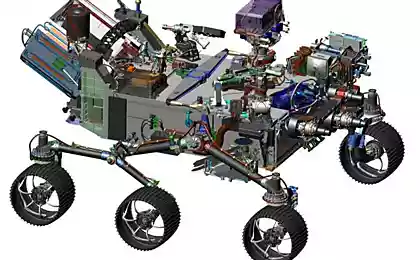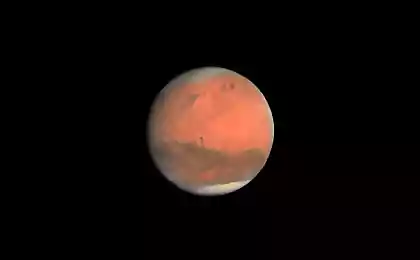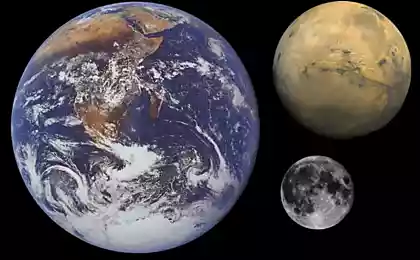1447
Mars rover Curiosity has completed basic scientific mission
Curiosity - year. A phrase I wrote, but today Martian year passed, which lasts a little less than two Earth years. Hours counted rover 668 Sols (Martian days), and it means that you can celebrate the anniversary of the epic Martian crater Gale.

Total journey overcome more than 8 kilometers, but the rover has not reached the main goal of his journey - mountain Aeolis (Sharpe), although carefully walks to her for over a year. Therefore, its main research and likely still ahead of the opening.
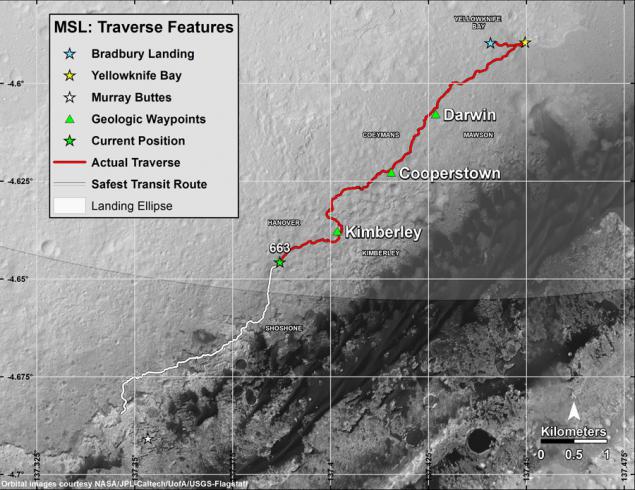
Originally, the term basic scientific mission was called in one Martian year. That is today Curiosity realized that at least, for which he was sent to Mars and NASA can now report that the work of the rover successfully. Of course none of it will not turn off, and he will continue to study full development of the resource, whom may be enough for 10-15 Earth years. Previously, for the previous generation of Mars rovers, NASA has named term basic research program in 90 days, but these plans Opportunity exceeded more than 40 times, we wish the same efficiency and Curiosity.
On the anniversary of the well would traditionally take stock. But the journey to the mountain led to the fact that at the time the research was paid significantly less than in the first months after planting. Therefore, new information has increased slightly since the time when we do a review on anniversary landing or итогам 2013 . Since then, the rover drilled a new well, and now the road is analyzing samples recruited.
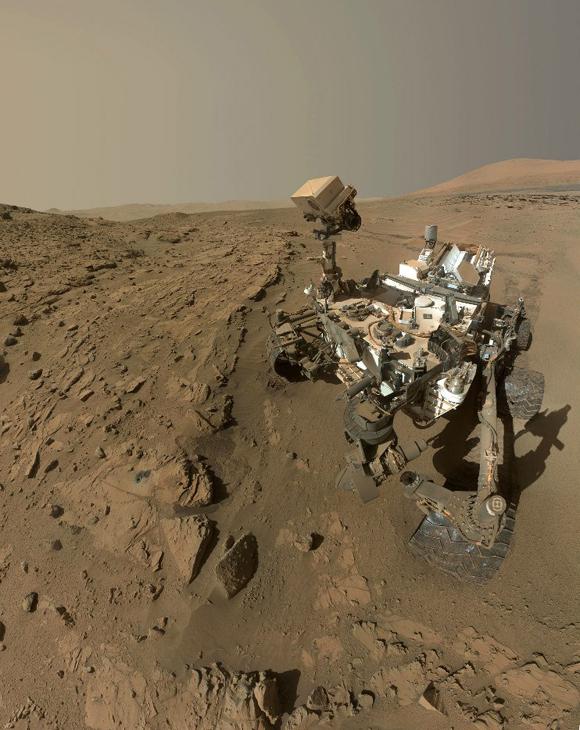
While we were told only that the drilled rock with a high content of feldspars, and therefore the geological history of the Martian crust may be more difficult than previously imagined.
Briefly recall the sake of which everything was started.
After Spirit and Opportunity have found clear evidence of warm and wet past Mars Science asked a new question: whether the conditions on Mars are suitable for the initiation and maintenance of life? To answer this and several other issues raised new powerful and heavy rover Curiosity. The answer he gave a surprisingly fast for everyone - just six months after the start of work: yes, on Mars, there were times when the atmosphere was denser on the planet that has not yet become red, flowing rivers, and the water there was safe to drink.
Was there life on Mars? Not yet known. Curiosity can only detect traces of organic compounds in the soil. Unfortunately, when planting occurred soiling SAM organic solvent, so now scientists can not say with any organics found on Mars, and what had brought with them. It is hoped that future research will more accurately calibrate the instrument and to speak more confidently about traces of organic compounds in the Martian soil.
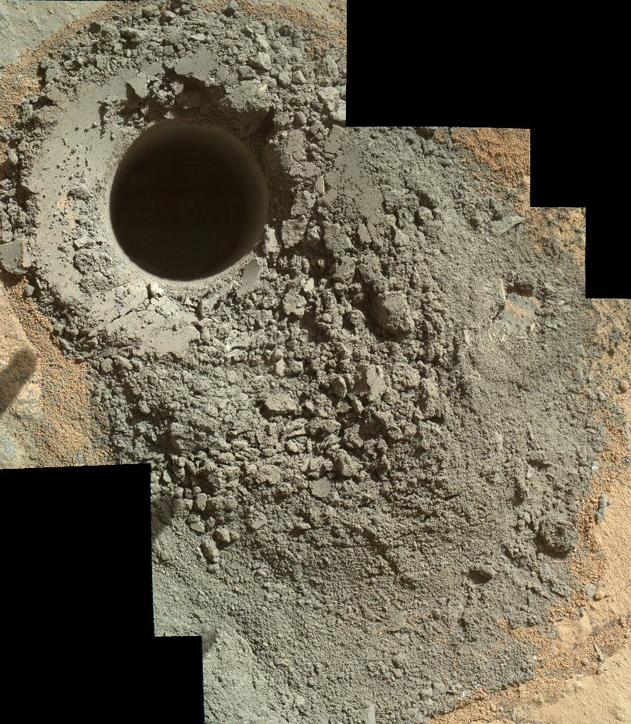
Along Curiosity made a very useful thing for future manned missions to Mars - measured the radiation in the air and on the surface. The results are encouraging: background during the flight was about two times higher than the International Space Station, and on the surface - like on the ISS. In other words, you can live and not necessarily dig bunkers under the meters thick layer of soil. With flight yet more difficult, but also realistic.
In addition, the rover has collected abundant information about the climate of Mars, on the isotopic composition of the atmosphere and soil minerals, conducted astronomical observations. But I tried to talk about it, as soon as new data.
On the anniversary of Curiosity told many media, so now I would like to draw attention to the various interesting little things that can be observed with Curiosity, and that, as a rule, do not fall from the official press release or publication of news agencies.
Talk about dust. Perhaps this is the only object whose movement we can observe on Mars. Not counting the rovers themselves naturally.
During the year covered dense dust "coat" the body of the rover.
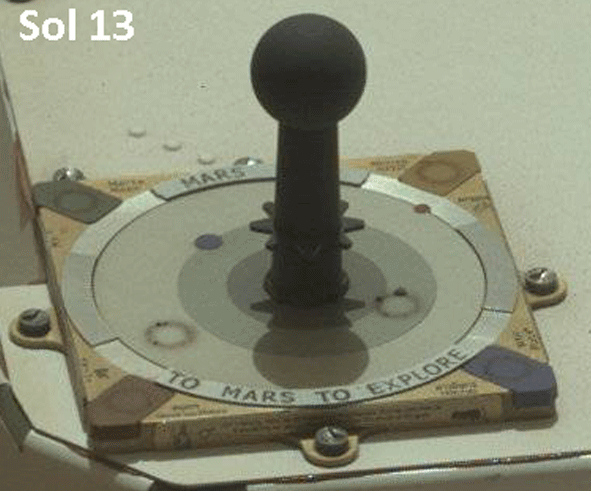
Unlike Opportunity, which is regularly cleaned local tornadoes, Curiosity sweeps stronger and stronger. As it turned out, in the crater Gale more or less strong tornadoes does not appear, apparently not those conditions. Small wind gusts were recorded, but never observed dust devil, like Opportunity.
Another interesting example of the motion of Mars can be observed when the vibration is transmitted from the rover on the ground. On the sandy slopes arise mikroopolzni which confirm that Mars seismically - dead planet. If its a little shaking the sand that had previously slipped.
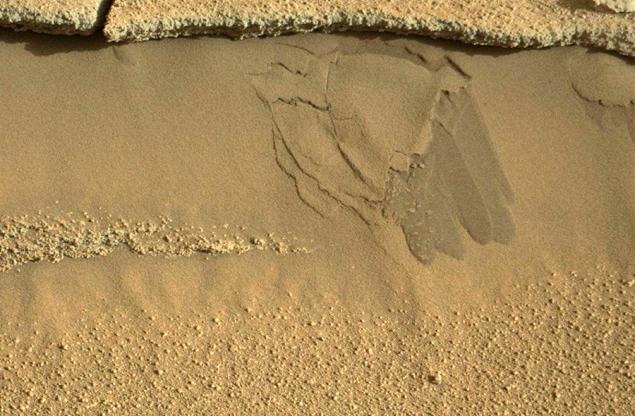
In fact, some of which are composed of counter Martian dunes - this is not the usual sand, and that somewhere between sand and dust. At American geologists have appropriate term «silt», which is different from sand and dust. Under certain conditions, this silt acquires properties comparable to a thick liquid. It was well marked when Curiosity started new drilling operations two months ago.
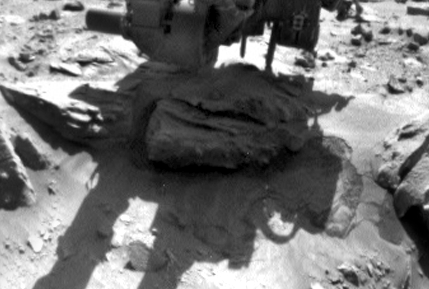
Boer Curiosity - punch it, and not just a drill. Turning vibrator on the manipulator, not only caused a landslide and micro earthquakes, but also very beneficial effect on the degree of dustiness cameras. Especially lucky camera MARDI, which is only set for shooting landing. She only did not close the dust cap when landing thrusters raising clouds of dust. As a result, MARDI betrayed footage very mediocre quality.
Once in Mars were made tidy two holes, MARDI began to show pictures already better.
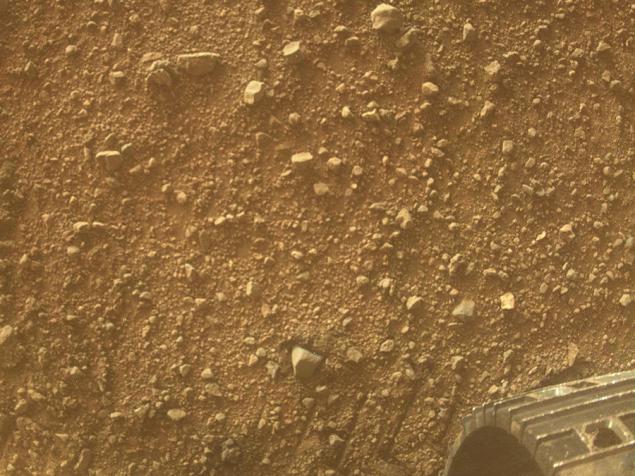
To celebrate, NASA has removed a new video that shows streaking the surface of Mars, under the wheels of Curiosity. While it is available to us only in the preview.

Full record will have to wait several weeks or months.
If we talk about the quality of the shooting of mast cells, the dust on their lenses also goes down, but only slightly, and begins to affect the image only if Curiosity long standing in one place. During movement shaking effectively cleans glass. More significant impact on the image quality affects the dust that constantly hangs in the atmosphere. With the ability to look at the mountains in the 30-50 km from the rover, we can observe transparency of the local "air". Once the Martian winter, conditions were such that it was possible to consider incredibly fine details on a ridge 25 kilometers from the rover.
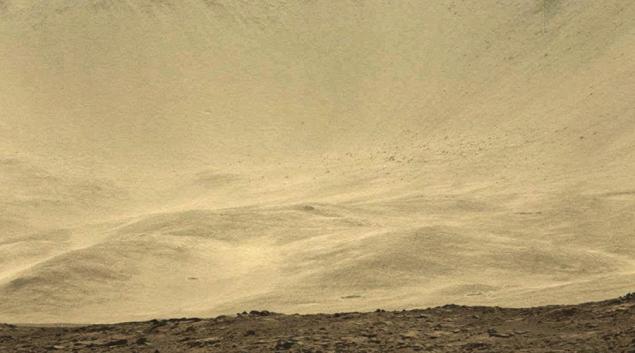
This quality of these slopes, I have not seen once, and, apparently, we will not see another year - until next winter.
The latest recent discovery Curiosity were three burly metal meteorite:
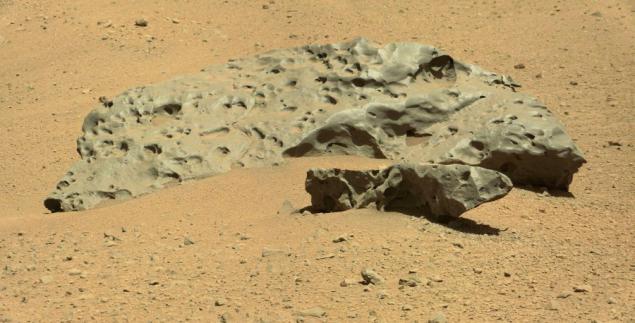
I expected them to suffer serious research, but, oddly enough, NASA was limited to only a cursory examination of 10 meters, and then the rover moved on. It seems so geologists mountain beckons Sharpe that they do not want any delays.
To its credit, the rover drivers is to say that now they scored a good pace. Kilometers for two months - it's very cool. The truth is now driven to the surface, which allows the drive without worrying about the condition of the wheels. Rents continue to rise, but rather slow, compared to the previous rate.
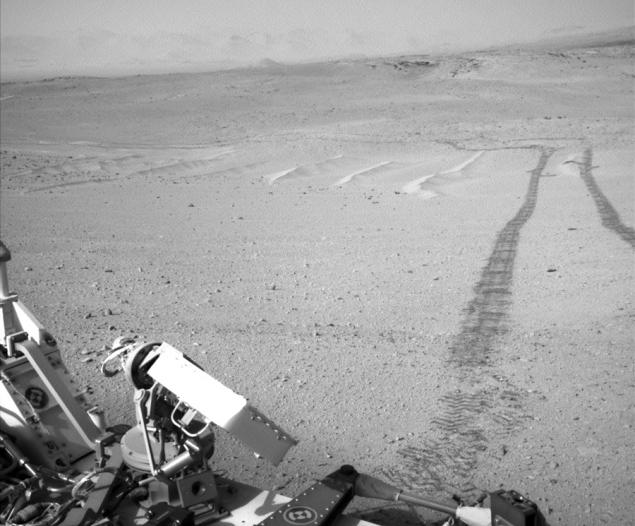
This sandy beach will continue for about a kilometer, and then begin a new type of surface, which is still unfamiliar, but is likely to be very tough. But come the end of the boring plains begin slopes and gullies, and therefore interesting findings on their bottom.
Source: habrahabr.ru/post/227669/

Total journey overcome more than 8 kilometers, but the rover has not reached the main goal of his journey - mountain Aeolis (Sharpe), although carefully walks to her for over a year. Therefore, its main research and likely still ahead of the opening.

Originally, the term basic scientific mission was called in one Martian year. That is today Curiosity realized that at least, for which he was sent to Mars and NASA can now report that the work of the rover successfully. Of course none of it will not turn off, and he will continue to study full development of the resource, whom may be enough for 10-15 Earth years. Previously, for the previous generation of Mars rovers, NASA has named term basic research program in 90 days, but these plans Opportunity exceeded more than 40 times, we wish the same efficiency and Curiosity.
On the anniversary of the well would traditionally take stock. But the journey to the mountain led to the fact that at the time the research was paid significantly less than in the first months after planting. Therefore, new information has increased slightly since the time when we do a review on anniversary landing or итогам 2013 . Since then, the rover drilled a new well, and now the road is analyzing samples recruited.

While we were told only that the drilled rock with a high content of feldspars, and therefore the geological history of the Martian crust may be more difficult than previously imagined.
Briefly recall the sake of which everything was started.
After Spirit and Opportunity have found clear evidence of warm and wet past Mars Science asked a new question: whether the conditions on Mars are suitable for the initiation and maintenance of life? To answer this and several other issues raised new powerful and heavy rover Curiosity. The answer he gave a surprisingly fast for everyone - just six months after the start of work: yes, on Mars, there were times when the atmosphere was denser on the planet that has not yet become red, flowing rivers, and the water there was safe to drink.
Was there life on Mars? Not yet known. Curiosity can only detect traces of organic compounds in the soil. Unfortunately, when planting occurred soiling SAM organic solvent, so now scientists can not say with any organics found on Mars, and what had brought with them. It is hoped that future research will more accurately calibrate the instrument and to speak more confidently about traces of organic compounds in the Martian soil.

Along Curiosity made a very useful thing for future manned missions to Mars - measured the radiation in the air and on the surface. The results are encouraging: background during the flight was about two times higher than the International Space Station, and on the surface - like on the ISS. In other words, you can live and not necessarily dig bunkers under the meters thick layer of soil. With flight yet more difficult, but also realistic.
In addition, the rover has collected abundant information about the climate of Mars, on the isotopic composition of the atmosphere and soil minerals, conducted astronomical observations. But I tried to talk about it, as soon as new data.
On the anniversary of Curiosity told many media, so now I would like to draw attention to the various interesting little things that can be observed with Curiosity, and that, as a rule, do not fall from the official press release or publication of news agencies.
Talk about dust. Perhaps this is the only object whose movement we can observe on Mars. Not counting the rovers themselves naturally.
During the year covered dense dust "coat" the body of the rover.

Unlike Opportunity, which is regularly cleaned local tornadoes, Curiosity sweeps stronger and stronger. As it turned out, in the crater Gale more or less strong tornadoes does not appear, apparently not those conditions. Small wind gusts were recorded, but never observed dust devil, like Opportunity.
Another interesting example of the motion of Mars can be observed when the vibration is transmitted from the rover on the ground. On the sandy slopes arise mikroopolzni which confirm that Mars seismically - dead planet. If its a little shaking the sand that had previously slipped.

In fact, some of which are composed of counter Martian dunes - this is not the usual sand, and that somewhere between sand and dust. At American geologists have appropriate term «silt», which is different from sand and dust. Under certain conditions, this silt acquires properties comparable to a thick liquid. It was well marked when Curiosity started new drilling operations two months ago.

Boer Curiosity - punch it, and not just a drill. Turning vibrator on the manipulator, not only caused a landslide and micro earthquakes, but also very beneficial effect on the degree of dustiness cameras. Especially lucky camera MARDI, which is only set for shooting landing. She only did not close the dust cap when landing thrusters raising clouds of dust. As a result, MARDI betrayed footage very mediocre quality.
Once in Mars were made tidy two holes, MARDI began to show pictures already better.

To celebrate, NASA has removed a new video that shows streaking the surface of Mars, under the wheels of Curiosity. While it is available to us only in the preview.

Full record will have to wait several weeks or months.
If we talk about the quality of the shooting of mast cells, the dust on their lenses also goes down, but only slightly, and begins to affect the image only if Curiosity long standing in one place. During movement shaking effectively cleans glass. More significant impact on the image quality affects the dust that constantly hangs in the atmosphere. With the ability to look at the mountains in the 30-50 km from the rover, we can observe transparency of the local "air". Once the Martian winter, conditions were such that it was possible to consider incredibly fine details on a ridge 25 kilometers from the rover.

This quality of these slopes, I have not seen once, and, apparently, we will not see another year - until next winter.
The latest recent discovery Curiosity were three burly metal meteorite:

I expected them to suffer serious research, but, oddly enough, NASA was limited to only a cursory examination of 10 meters, and then the rover moved on. It seems so geologists mountain beckons Sharpe that they do not want any delays.
To its credit, the rover drivers is to say that now they scored a good pace. Kilometers for two months - it's very cool. The truth is now driven to the surface, which allows the drive without worrying about the condition of the wheels. Rents continue to rise, but rather slow, compared to the previous rate.

This sandy beach will continue for about a kilometer, and then begin a new type of surface, which is still unfamiliar, but is likely to be very tough. But come the end of the boring plains begin slopes and gullies, and therefore interesting findings on their bottom.
Source: habrahabr.ru/post/227669/
The State Duma is going to introduce restrictions on the payment systems
It is fascinating - the robot adjusts guitar







